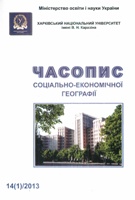New paths towards sustainable rural development: lessons from Southeastern Anatolia region development plan in Turkey
Keywords:
Regional Development Plan, Participatory, Sustainable Regional Development, Southeastern Anatolia Region, The Southeastern Anatolia Project (GAP).
Abstract
The aim of this study is to analyse and to bring out the different aspects of the revised version of the GAP Master Plan. For this reason, firstly, the steps of the plan from the first version to last one will be examined. Next, both regional and national cases and conditions will be evaluated. In the third step the participatory and sustainable dimensions of the GAP Master Plan will be discussed. And, in the last step, in order to complete project in time planned, what should be done and lessons learned from the process will be analyzed.
Downloads
Download data is not yet available.
References
1. Acma, Bulent (2001). New Approaches To Regional Development: The Southeastern Anatolia Project (GAP) In Turkey, Invited paper in 17th Pacific Conference Regional Science Association International Congerence, Port-land-Oregon, June 30-July 4 2001.
2. Acma, Bulent (2001). Sustainable Regional Development: The GAP Project in Turkey ,Invited paper in Interna-tonal Atlantic Economic Conferences, Athens, in Greece 13-20 March 2001.
3. Acma, Bulent (2000).Industrialization Strategy of Southeastern Anatolia Project iTurkey, Invited paper in APDR Conferences, Ponta Delgade University of Azores, in Portugal 29 June-2 July 2000.
4. GAP Administration (2010). Socio-economic Indicators, GAP-Turkey, September 2010, in Turkish, Sanliurfa, Turkey.
5. GAP Administration (2010). Latest State in GAP, Ankara, September 2010.
6. GAP Administration (2002). GAP Regional Development Plan, Republic of Turkey Prime Ministry, in Turkish, Ankara.
7. GAP Administration (September 1999). Latest State in GAP, Republic of Turkey Prime Ministry, Ankara.
8. GAP Administration (1998). Social Policy Objectives, GAP Regional Development Administration, Ankara.
9. GAP Administration and UNDP (September 1997). Sustainable Development Programme in GAP, Republic of Turkey Prime Ministry, in Turkish, Ankara.
10. GAP Administration (April 1996). GAP Project an Innovative Approach to Integrated Sustainable Regional Development, Republic of Turkey Prime Ministry, Ankara.
11. GAP Administration (1993). GAP Action Plan, Republic of Turkey Prime Ministry, in Turkish, Ankara.
12. GAP Administration (1993).Social Trends ant Attitudes Towards Transformation in GAP Region, Republic of Turkey Prime Ministry, in Turkish, Ankara.
13. Ozbilen, Vedat (2001). A Participatory Approach in the Southeastern Anatolia Region Development Plan(2002-2010), GAP Regional Development Administration, International Workshop for the Southeastern Anatolia Region Development Plan, 3-5 January, Antalya.
14. Republic of Turkey Prime Minister(1991). GAP Master Plan. Ankara.
15. Yasinok, Kaya (2000).A Case Study of Participatory Resettlement in GAP, Southeastern Anatolia Project, GAP Regional Development Administration, World Water Forum, The Hague, The Netherlands.
16. United Nations (1992). Agenda 21: Programme of Action for Sustainable Development. New York: United Nations.
17. Unver, Olcay (1997). Southeastern Anatolia Integrated Development Project(GAP), Turkey; An Overview of Is-sues of Sustainability, Water Resources Development, Vol: 13, No:2
18. Unver, Olcay and Ravij K., Grupta (2002). Water Resources Management, METU Press, Ankara.
19. Unver, Olcay (1999). A Pioneering Model for Water-Based Regional Development, International Workshop on Water-Based Development Projects, Experience in the World, GAP Regional Development Administration, 8-10 November, Sanliurfa.
2. Acma, Bulent (2001). Sustainable Regional Development: The GAP Project in Turkey ,Invited paper in Interna-tonal Atlantic Economic Conferences, Athens, in Greece 13-20 March 2001.
3. Acma, Bulent (2000).Industrialization Strategy of Southeastern Anatolia Project iTurkey, Invited paper in APDR Conferences, Ponta Delgade University of Azores, in Portugal 29 June-2 July 2000.
4. GAP Administration (2010). Socio-economic Indicators, GAP-Turkey, September 2010, in Turkish, Sanliurfa, Turkey.
5. GAP Administration (2010). Latest State in GAP, Ankara, September 2010.
6. GAP Administration (2002). GAP Regional Development Plan, Republic of Turkey Prime Ministry, in Turkish, Ankara.
7. GAP Administration (September 1999). Latest State in GAP, Republic of Turkey Prime Ministry, Ankara.
8. GAP Administration (1998). Social Policy Objectives, GAP Regional Development Administration, Ankara.
9. GAP Administration and UNDP (September 1997). Sustainable Development Programme in GAP, Republic of Turkey Prime Ministry, in Turkish, Ankara.
10. GAP Administration (April 1996). GAP Project an Innovative Approach to Integrated Sustainable Regional Development, Republic of Turkey Prime Ministry, Ankara.
11. GAP Administration (1993). GAP Action Plan, Republic of Turkey Prime Ministry, in Turkish, Ankara.
12. GAP Administration (1993).Social Trends ant Attitudes Towards Transformation in GAP Region, Republic of Turkey Prime Ministry, in Turkish, Ankara.
13. Ozbilen, Vedat (2001). A Participatory Approach in the Southeastern Anatolia Region Development Plan(2002-2010), GAP Regional Development Administration, International Workshop for the Southeastern Anatolia Region Development Plan, 3-5 January, Antalya.
14. Republic of Turkey Prime Minister(1991). GAP Master Plan. Ankara.
15. Yasinok, Kaya (2000).A Case Study of Participatory Resettlement in GAP, Southeastern Anatolia Project, GAP Regional Development Administration, World Water Forum, The Hague, The Netherlands.
16. United Nations (1992). Agenda 21: Programme of Action for Sustainable Development. New York: United Nations.
17. Unver, Olcay (1997). Southeastern Anatolia Integrated Development Project(GAP), Turkey; An Overview of Is-sues of Sustainability, Water Resources Development, Vol: 13, No:2
18. Unver, Olcay and Ravij K., Grupta (2002). Water Resources Management, METU Press, Ankara.
19. Unver, Olcay (1999). A Pioneering Model for Water-Based Regional Development, International Workshop on Water-Based Development Projects, Experience in the World, GAP Regional Development Administration, 8-10 November, Sanliurfa.
Published
2014-06-10
Cited
How to Cite
Acma, B. (2014). New paths towards sustainable rural development: lessons from Southeastern Anatolia region development plan in Turkey. Human Geography Journal, 14(1), 70-78. https://doi.org/10.26565/2076-1333-2013-14-11
Section
Наукові повідомлення




